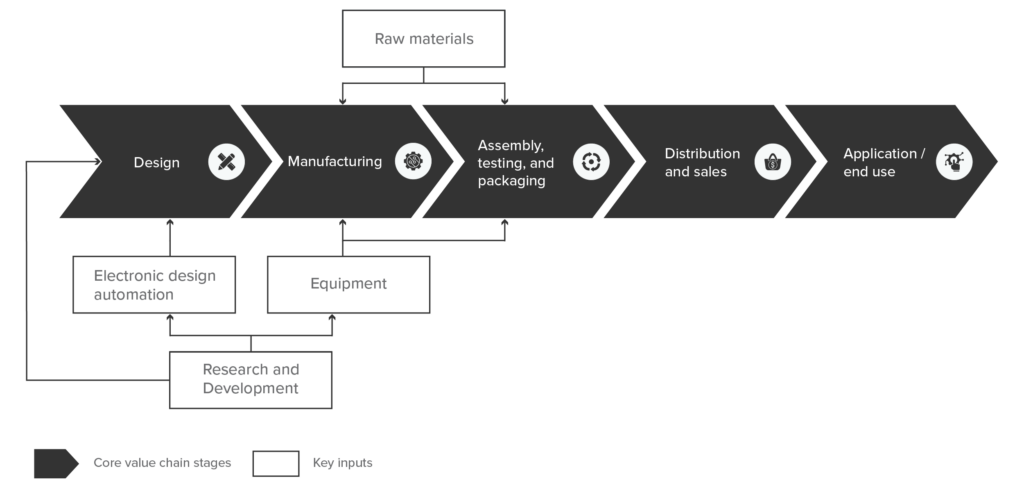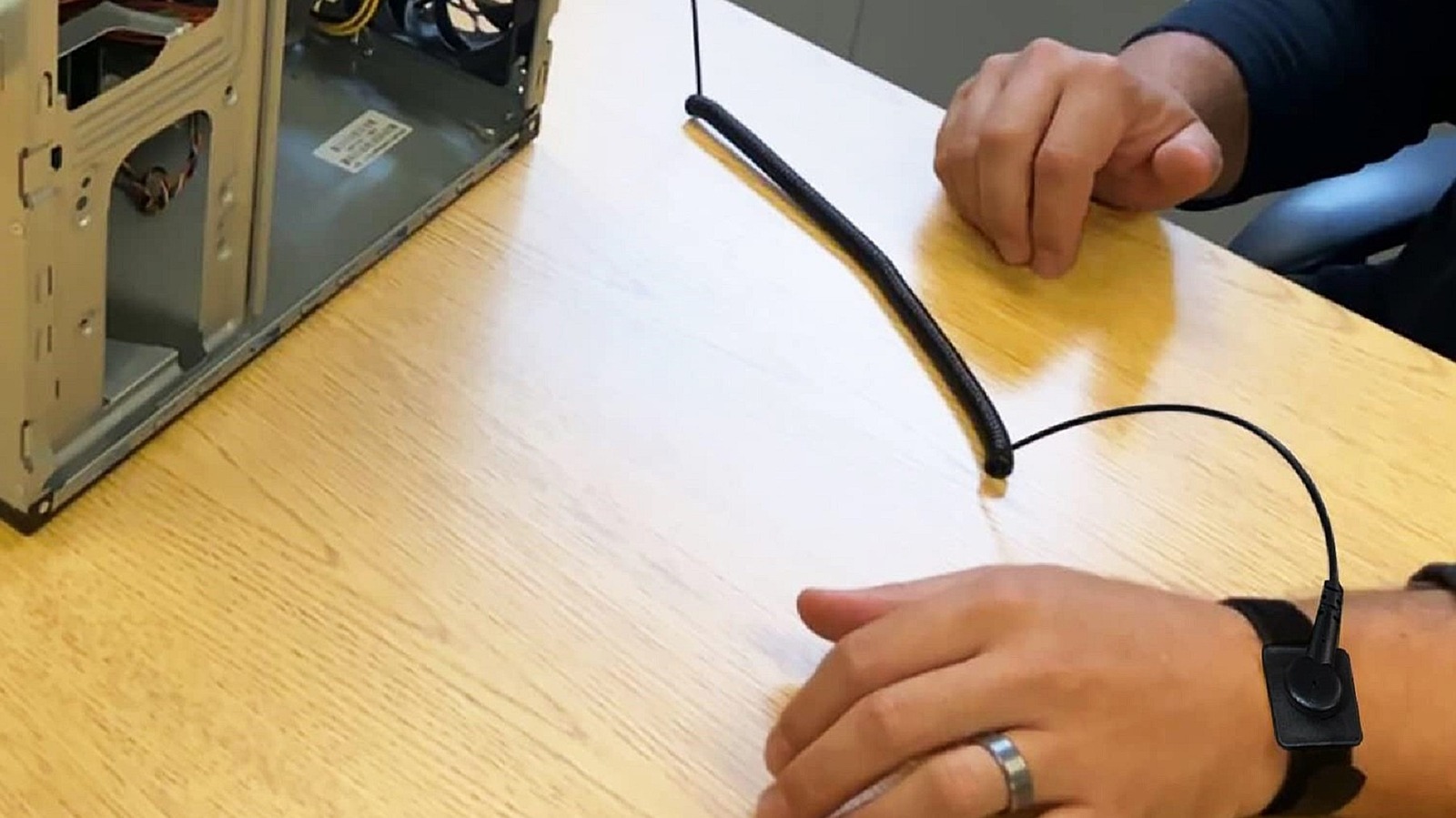Technology & Innovation
June 11, 2025
Reprogramming the future: The specialized semiconductors reshaping the global supply chain
Introduction
In 2014, the People’s Republic of China (PRC) launched a massive investment campaign to develop its domestic semiconductor industry. While significant policy and media attention is focused on PRC efforts to catch up to the United States at the leading edge of semiconductor manufacturing, PRC investments in foundational, or “lagging-edge,” semiconductors are also an important strategic development. In this issue brief, the authors examine PRC investments in field-programmable gate arrays (FPGAs) as an example of critical, specialized semiconductors that are often manufactured with foundational technology.
FPGAs are specialized semiconductor chips that offer a unique combination of flexibility and performance. They are critical components in guided missile systems like the FGM-148 Javelin, automobiles like the Mustang Mach-E electric SUV, telecommunications systems, and cloud data centers. Today, the United States leads the FPGA industry. US firms hold market-leading positions in FPGA design and design software, while most FPGA manufacturing and assembly, testing, and packaging is conducted by US firms or by close allies such as Taiwan.
However, the PRC has steadily increased its semiconductor investment efforts in recent years to develop manufacturing capabilities for foundational semiconductors overall, and design capabilities for FPGAs in particular. This new PRC capacity will come online in one to three years and, given its substantial scale, it may price US FPGA firms out of the critical segments of the FPGA market. This will create both availability and security risks for the US FPGA supply chain.
Semiconductors are at the heart of US-China tech tensions
In the last decade, US and PRC policy postures toward the semiconductor industry have changed. As the overall US-China relationship shifted from collaboration to competition, the US-China semiconductor ecosystem has evolved from a benign mutualistic partnership into a strategic competition. This shift, coupled with rising tensions between the United States and the PRC overall, triggered a broad US response, including prohibiting PRC investments, imposing export controls on critical chips and manufacturing equipment, and an industrial policy that supports domestic chipmakers. Key PRC and US actions are summarized in Figure 1.
Figure 1. What steps have the United States and China taken in the race for semiconductor supremacy?
China’s chip strategy is powered by state funding and localized supply chains
In 2014, after the Chinese Communist Party (CCP)articulated its ambitions to become a leader across the semiconductor value chain by 2030, it quickly established a National Integrated Circuit Industry Investment Fund (NICIIF, commonly known as the “Big Fund”) to provide financial support toward those goals. The first phase of funding, amounting to an estimated $21 billion, supported domestic semiconductor manufacturing and chip design capabilities, largely through overseas acquisitions and foreign semiconductor equipment purchases.
In 2018, China revised its goal to focus on increasing domestic semiconductor production as part of its Made in China 2025 industrial strategy. In the same year, a series of articles appeared in a publication affiliated with the PRC Ministry of Science and Technology. They identified specific “chokepoint technologies,” including both semiconductors and the photolithography machines needed to manufacture them.
The second phase of Big Fund investments took place in October 2019, providing an estimated $28.9 billion, to support upstream development and downstream acquisition of semiconductor manufacturing equipment, along with critical raw materials. In 2021, the PRC began to supplement Big Fund investments with an explicit dual circulation and indigenous innovation strategy, aiming to replace US- and foreign-made semiconductors with domestic alternatives.
Chinese companies, including those with long-term US ties, are increasingly supporting the PRC government’s initiatives to develop a localized semiconductor supply chain. Between 2018 and 2023, the PRC produced 34 percent of the world’s chip design and fabrication-related research articles while the United States trailed behind at 15 percent. Nine out of the world’s top ten chip research producers are also PRC institutions. Of course, these statistics should be read with some skepticism, as China has often produced large volumes of lower-quality research publications. However, the sheer quantity of chip-related publications produced by Chinese researchers indicates the PRC’s substantial resource allocation and strategic commitment to advancing its broader semiconductor industry.
In 2024, China announced the third phase of the Big Fund, an estimated $47.5 billion investment focused on chip-making equipment. However, total PRC semiconductor investment fell sharply in 2024, with analysts attributing the decline to reduced demand and lower government subsidies.
While the PRC is building capabilities to design and manufacture leading-edge semiconductors, it is also strengthening its capacity to produce lagging-edge semiconductors. Jeremy Mark, a senior fellow with the GeoEconomics Center of the , observed that “China has an insatiable appetite for all types of semiconductors and investments have been, by necessity, in legacy chips.” As part of the PRC’s efforts, PRC FPGA firms are growing. This upward trend demands increased concern even though China’s current FPGA sector is relatively nascent compared to the United States.
From Obama to Trump—the US response to PRC investments
The US government has countered China’s semiconductor advancements through intensified foreign investment reviews and export controls, while also tightening US outbound investments into China’s semiconductor sector. The Committee on Foreign Investment in the United States (CFIUS) has blocked PRC state investments and acquisitions of semiconductor firms consistently across recent presidential administrations. For instance, in 2016, the Obama administration prohibited the sale of the US operations of Aixtron GE, a semiconductor manufacturing equipment firm headquartered in Germany, to a PRC investment firm. The following year, the Trump administration blocked the PRC acquisition of the Lattice Semiconductor Corporation, a US FPGA firm, on similar national security grounds.
Since 2020, US policy to counter PRC semiconductor industry growth has largely relied on the assumption that the United States and its allies control technological chokepoints, and can deny the PRC access to them using export controls. This approach is largely in-line with the “chokepoint effect” model of weaponized interdependence, as proposed by Henry Farrell and Abraham Newman. Recent policy discussion has begun to question whether efforts to deny access to chokepoints in fact incentivize indigenous PRC technological development, a concern raised in Farrell and Newman’s original paper. Similar US efforts to take advantage of chokepoints in the global financial system have spurred both the PRC and US allies in Europe to develop technological solutions to reduce the importance of US-controlled chokepoints. Additionally, the US has also increasingly relied on executive directives to limit Chinese access to American capital, beginning with Executive Order 13959 issued by President Donald Trump in 2020, which prohibited US investments in designated Communist Chinese Military Companies (CCMCs). In 2021, President Joe Biden amended EO 13959 and revoked EO 13974 by issuing EO 14032, which expanded the scope to include companies supporting the Chinese Military-Industrial Complex (CMIC) and surveillance efforts while also narrowing investment restrictions by prohibiting indirect investments in CMIC-linked companies. In 2023, Biden signed Executive Order 14105, authorizing the Treasury Department to restrict or require disclosure of US investments in sensitive technologies—such as semiconductors—in countries of concern, particularly China.
As shown in Figure 1, US actions against the PRC semiconductor industry began to increase during the Trump administration in 2018 and carried over to the Biden administration. In response to US restrictions, the PRC enacted similar controls to impose pressure on US firms and its semiconductor industry.
China’s growing involvement in the FPGA industry
The FPGA market has become a key competitive arena between the United States and the PRC. While the United States is still the global leader in FPGAs, China’s substantial investments in the FPGA space present an emerging challenge to the United States’ ability to produce the most advanced FPGA chips and potentially the ability of the United States and its allies to manufacture FPGAs at scale. Our research indicates that the PRC is launching a major buildup of manufacturing capacity at lagging-edge logic nodes, including substantial state investments in FPGA firms.
To analyze the FPGA industry and China’s growing involvement, we employ the value chain model described in Figure 2, which includes both core stages of the semiconductor value chain and key inputs.
Figure 2. An overview of the semiconductor value chain, from initial design through end use

The participants in the FPGA supply chain are grouped into four main categories.
China is increasing its efforts to localize FPGA production in response to growing domestic demands, aiming to decrease reliance on US suppliers, particularly for low- and mid-range FPGAs. US sanctions and export controls have limited China’s access to advanced semiconductor manufacturing equipment, prompting China to increase investments in lagging-edge semiconductor capacity that depends on older, less-sophisticated semiconductor manufacturing equipment (SME). The PRC currently holds an advantage in certain aspects of manufacturing and the majority of assembly, testing, and packaging (ATP), while also making significant investments in domestic FPGA firms, specifically in R&D to strengthen its FPGA chipmakers’ design capabilities.
US manufacturers pay the price for China’s chokehold on critical raw materials
China is the leading supplier of raw materials needed for FPGA manufacturing, specifically silicon and gallium. In 2024, the PRC produced approximately 80 percent of global silicon production and 99 percent of worldwide low-purity gallium production. Given China’s history of using its critical mineral supply as a geopolitical tool, mounting competition between the United States and the PRC increases the likelihood of PRC restrictions on critical minerals. The PRC’s actions to control raw materials to-date—including China’s complete ban on gallium exports to the United States in December 2024 and stricter licensing requirements for other critical minerals in April 2025—have significantly increased prices for various raw materials, including gallium. Even before China’s April 2025 measures, gallium prices had already risen by roughly 80 percent by December 2024, thereby increasing the cost of US FPGA manufacturing.
While other countries could step in over time to provide additional gallium capacity, prices may remain elevated or increase further before US and allied gallium production can increase. However, gallium is only one of many critical inputs used in FPGA manufacturing, and many FPGA end customers are largely price-inelastic (e.g., military and defense applications). This implies that gallium pricing dynamics alone are unlikely to drive major shifts in the FPGA market. China’s dominance and strategic manipulation of its raw material supply reduce the cost of domestic Chinese FPGA manufacturing while driving up manufacturing cost for US FPGAs.
Ensuring continued dominance in assembly, testing, packaging
ATP involves separating silicon wafers into individual chips, which are then connected with other components and packaged into an end product. ATP services are typically outsourced to third-party semiconductor assembly and testing (OSAT) firms. While China and Taiwan make up 60 percent of global ATP operations, China is home to five of the largest OSAT firms globally (JCET, HT-Tch, TF, LCSP, and Chippacking) and is investing in its next-generation advanced packaging capabilities. As the semiconductor industry—including FPGA firms—increasingly relies on advanced packaging to drive performance gains, China’s advancements in next-generation packaging techniques may increasingly position the country as a significant competitor in the FPGA space and in critical end-customer applications that depend on them, such as artificial intelligence (AI) and data centers.
Big Fund investment fuels the rise of PRC FPGA firms
Investments from the Big Fund in PRC FPGA firms like Anlogic provide early indicators that FPGAs are a focus area for the PRC. According to the ’s Jeremy Mark, there is “no evidence that there is a slacking of [Chinese] investments and commitment of resources toward semiconductors and SMEs [as] its technology growth strategy, particularly in AI, requires semiconductors.” This manufacturing capacity will provide firms with an option to manufacture FPGA chips at costs substantially lower than what is typical today. However, this new manufacturing capacity will likely come with substantial availability and security risks.
There are five notable PRC FPGA firms in the low-to-mid-range FPGA segment:
- Anlogic (安路科技): Anlogic is the largest domestic FPGA vendor in China, although it trails three US firms in Chinese market share. Anlogic held 38.2 percent of the domestic low-end FPGA market share as of 2019 and mainly targets industrial and automotive applications. Anlogic has received significant support from the PRC government in 2019 through the Big Fund. Anlogic reportedly spends at least 40 percent of its revenue on research and development (R&D).
- Gowin Semiconductor (高云半导体): Gowin Semiconductor is gaining domestic market share, specifically in IoT, automotive, and industrial applications. Founded in 2014, Gowin has attracted multiple government-backed investments. In May 2022, Guangzhou Bay Area Semiconductor Group, a state-backed fund, led the most recent funding round and emerged as Gowin’s largest shareholder This funding is expected to be used for expanding R&D as well as target new markets. Gowin is the only PRC FPGA supplier with an automotive-grade FPGA certification.
- Shanghai Fudan Microelectronics Group (上海复旦): Fudan Microelectronics is a state-affiliated integrated circuit (IC) design company that originated from Fudan University in 1998. In 2024, Fudan Microelectronics spent roughly a third of its revenue on R&D. Although the Big Fund does not appear to have invested directly in Fudan Microelectronics, the company receives investments from state-affiliated financial entities and significant government research grants.
- Shenzhen Pango Microsystems (紫光同创): Pango Microsystems is the largest FPGA supplier to Huawei and seeks to expand into advanced FPGAs. Pango has also attracted investments from government-backed entities. The firm reportedly dedicates 80 percent of its 800-plus staff to R&D.
- Hercules Microelectronics (京微齐力): Hercules Microelectronics, founded in 2017, focuses on FPGAs for AI acceleration, data centers, and electronic vehicles. Although not directly backed by the Big Fund, Hercules Microelectronics received funding from investment funds linked with the Beijing municipal government.
These examples demonstrate the level of financial support the PRC government supplies to FPGA firms, both through the Big Fund and other initiatives. A significant portion of this funding is directed toward R&D efforts, enabling PRC FPGA firms to expand their capabilities and compete more effectively with established US FPGA firms. However, while Big Fund support appears to have played a key role in building PRC FPGA firms, it has not been able to drive long-term, sustainable growth. For example, its pre-IPO investment in Anlogic likely strengthened investor confidence in the firm and helped the company raise approximately $186.04 million. This capital infusion supported significant R&D efforts, resulting in six new chips being released in 2022. As a result, Anlogic revenue surged from $105.16 million to $154.83 million, with net profit of $8.89 million. However, as the semiconductor industry slowed between 2022 and 2023, the Big Fund reduced its Anlogic holdings from roughly 39 million shares to 31 million shares and Anlogic experienced a substantial 2023 net loss of $27.87 million, primarily driven by weak downstream demand and its continued aggressive R&D spending of $54.3 million. The trend persisted in 2024, with Anlogic reporting another net loss of $28.54 million, despite reducing its R&D spend by about 7 percent.
Figure 3. Anlogic’s revenue and profit have declined without sustained Big Fund investment
Anlogic’s recent performance highlights three key takeaways. First, Big Fund investments appear to have provided critical capital that enabled Anlogic to enter and compete in the FPGA market with rapid, extensive R&D. Second, Anlogic has struggled to sustain profitability through semiconductor market swings without ongoing capital support. Third, despite financial pressures, Anlogic and similar firms remain committed to aggressive R&D investment to enhance their competitiveness and improve their product portfolios, ultimately enabling them to offer high-quality FPGAs at lower costs.
Conclusion
The FPGA market is highly segmented and the substantial customization of FPGA designs needed for different applications can form a significant barrier to entry. However, rapid, large-scale PRC investment in lagging-edge semiconductors has established more than just the five FPGA design firms highlighted above and has increased substantial manufacturing capacity at lagging-edge process nodes, which will ramp up PRC FPGA production in the near future. The PRC FPGA firms described above collectively address a broad set of critical FPGA segments, with considerable support from the PRC government.
This development poses two principal concerns for the United States. First, these FPGAs will enable the PRC to develop new capabilities across its economy and for military purposes. Second, if geopolitics allows global technology standards and supply chains to remain integrated, US FPGA makers may struggle to compete with these new PRC players given the scale and degree of their government support. FPGAs are critical components in US defense equipment and underpin US critical infrastructures as well as significant economic activity. To protect US national security and economic interests, the US government should consider launching a dedicated effort to address the impact of PRC FPGA firms on the resilience of US FPGA supply chain.
About the Authors
Celine Lee holds a Master of Public Policy from the Harvard Kennedy School and previously held fellowships at the United States Senate Committee on Foreign Relations and the American Institute in Taiwan (AIT).
Andrew Kidd holds a Master of Public Policy from the Harvard Kennedy School and was previously an engagement manager in the high-tech and public sector practices at McKinsey & Company.
Bruce Schneier is a security technologist and a fellow and lecturer at the Harvard Kennedy School.
Explore the program

The ’s Cyber Statecraft Initiative, part of the Technology Programs, works at the nexus of geopolitics and cybersecurity to craft strategies to help shape the conduct of statecraft and to better inform and secure users of technology.








